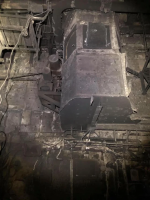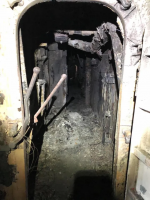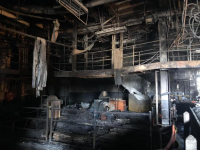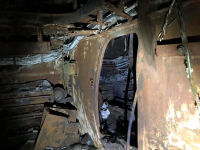You are using an out of date browser. It may not display this or other websites correctly.
You should upgrade or use an alternative browser.
You should upgrade or use an alternative browser.
USS Bonhomme Richard on fire
- Thread starter dapaterson
- Start date
The USMC is in the process of a very drastic reorganization (As someone else mentioned in this thread previously) - with less focus on big, manpower & equipment heavy ships - and more about distributed operations, and providing capabilities that aren't overlapped with the Army.
This might turn out to be the fastest self-divesting asset they have under the new plan ^-^
(Although the USMC doesn't seem to waste any time... they just held a final parade while the last of their M1A1 tanks were loaded onto trains and trailers & driven off about a week ago)
This might turn out to be the fastest self-divesting asset they have under the new plan ^-^
(Although the USMC doesn't seem to waste any time... they just held a final parade while the last of their M1A1 tanks were loaded onto trains and trailers & driven off about a week ago)
- Reaction score
- 2,091
- Points
- 1,160
USS Tripoli (America class LHA) commissioned today.
- Reaction score
- 2,091
- Points
- 1,160
NavyShooter said:I think the words you're seeking are "Detonation" vs "Deflagration".
Detonation means a rather energetic release resulting in an Earth Shattering Kaboom.
Deflagration means a rather energetic release, but at a slower rate of expansion resulting in a really big plume of really hot fire.
The class of the ammunition has an impact on this - ammo is broken down into 4 main classes - 1.1, 1.2, 1.3, and, 1.4.
There are sub-classes within those (1.4S) denoting specific characteristics, however, the only munitions that I would think they'd leave onboard during a refit such as this would be small arms ammunition, and possibly some pyrotechnics such as flares and such. These fall into 1.3 and 1.4 classes.
1.1 and 1.2 is the real energetic stuff - the "High" explosives that we enjoy watching go boom.
I do not have any knowledge about what the capacity of one of these ships is, but I can imagine that it is an order of magnitude larger than what we carry on our ships, particularly since it's a ship designed to support troops going ashore, plus helicopters and aircraft dropping bombs, firing missiles and guns. If the ship was fully loaded with HE, they'd be either fighting the fire madly, trying to get to the magazines before they blew, or, evacuating blocks of space.
Consider. Here's a 'guess' at what a single magazine might contain:
500 lb bomb x 200
Sidewinder missile x 50
Hellfire missile x 500
20mm HE ammo x 50,000
The Net Explosive Quantity on these items would be:
87 Kg x 200 = 17,400 Kg
9.4 Kg x 50 = 470 Kg
8.2 Kg x 500 = 4,100 Kg
0.010 Kg x 50,000 = 500 Kg
That's a total NEQ of 22,470 Kg.
...
0.02 Megatons sounds scarier!!!
CloudCover said:USS Tripoli (America class LHA) commissioned today.
That timing couldn't have been better ;D
FJAG
Army.ca Legend
- Reaction score
- 13,819
- Points
- 1,160
CBH99 said:That timing couldn't have been better ;D
It looks like the yard can build one at a time and they do take a long time from "laid down" to commissioning. There seem to be plans to build up to 11 of these so it's not like it's easy to fit a new one into the schedule.
As a Type 0, the Tripoli does not have a well deck like the BHR so it's not a one-for-one here. It's a Landing Helicopter Assault (HLA) rather than a Landing Helicopter Dock (LHD) amphibious like the Wasp Class.
:cheers:
- Reaction score
- 2,091
- Points
- 1,160
To well deck or not to well deck. Which LHA design fits better to the new USMC mission models? Don’t forget they have ~15 of the brand new SAN Antonio class LPD for gator work.
- Reaction score
- 146
- Points
- 710
Conclusion of an article at War on the Rocks:
Mark
Ottawa
...in the past few days, some have raised the question of whether this fire is just one more in a series of events over the past few years that indicates something is wrong with the Navy on a systemic level. There have been collisions of ships and reliefs of Navy secretaries, would-be chiefs of naval operations, and aircraft carrier commanding officers and program managers. Now, there is also a ship burning at a pier. The mounting record of scandal, buffoonery, and bad news seems to point at something fundamentally wrong with the Navy — and it is getting harder to refute this charge. But refute it I will.
I spend a lot of time thinking about the Navy — its direction, character, design, reputation, and mistakes. I have also spent an inordinate amount of time thinking about the last three years of bad news. In doing so, I have wracked my brain in order to find common elements in the disasters and scandals that lend themselves to pre-conceived solutions. Some will dismiss my thoughts as the ruminations of a hopeless advocate, too close to the problem to see that there is one. So, here are a few questions for those who point at the systemic failure argument:
What are the systemic issues you believe are at the heart of the Navy’s problem?
Can these systemic issues be decomposed into discrete contributors that a reasonable person would agree can be directly tied to actual setbacks?
If what we see is a problem of culture, which elements of the culture contributed to that problem? How would you go about changing these elements? Where are these enhancements most efficiently and effectively focused to achieve the desired changes? How would you ensure that the positive elements of the culture are retained?
If what you see is a leadership problem, which leaders are implicated? At what level? What could they be doing better? Is it because the Navy picked the wrong leaders? How do you know? If the Navy did pick the wrong leaders, how would you alter the process to achieve your desired results?
There is a certain blithe incompleteness bound up in the systemic failure argument unless one is willing to do the hard work of decomposition into actionable approaches tied to observed problems. I have not seen much in the way of good thinking on this subject.
Where does this leave Navy leadership as it deals with perceptions of incompetence and the recent record that seems to support it? Try this: Assume that no matter what it is you are doing — at whatever level of command you operate — that you are not quite as good at it as you think you are. Moreover, take immediate action no matter how small that action might be to remedy it and tell your subordinates that this is what you are doing. There is no level of authority in the Navy that is beyond this approach. It is not a mindset that requires vast infusions of resources and it promotes a fundamentals-based response to problems of great complexity. What it requires is brave self-assessment and a fearless dedication to improvement. Until such time as an internally consistent systemic argument for the Navy’s ills surfaces, this is a sound guide to the first steps to improvement.
https://warontherocks.com/2020/07/more-than-just-a-fire-the-implications-of-the-bonhomme-richard-catastrophe/
Mark
Ottawa
- Reaction score
- 17,116
- Points
- 1,010
That is a great article, Mark.
And since the CAF tends to mindlessly import every management trend/technique/fad from the US military, I would say their problems are also our problems.
And since the CAF tends to mindlessly import every management trend/technique/fad from the US military, I would say their problems are also our problems.
FJAG
Army.ca Legend
- Reaction score
- 13,819
- Points
- 1,160
CloudCover said:To well deck or not to well deck. Which LHA design fits better to the new USMC mission models? Don’t forget they have ~15 of the brand new SAN Antonio class LPD for gator work.
There are only two Type 0 the Tripoli being the last. The rest of the America Class are to be Type 1's which are the "dock" with well deck version. Interesting question though. With the step back from the USMC "heavy" elements will there be such a need for "docks" or will the replacement systems such as more HIMARS also require the well decks?
:dunno:
- Reaction score
- 213
- Points
- 880
FJAG said:There are only two Type 0 the Tripoli being the last. The rest of the America Class are to be Type 1's which are the "dock" with well deck version. Interesting question though. With the step back from the USMC "heavy" elements will there be such a need for "docks" or will the replacement systems such as more HIMARS also require the well decks?
:dunno:
I'm under the impression that they hope to procure much smaller, lighter amphibious ships to shuttle HIMARS or small groups of Marines around in.
FJAG
Army.ca Legend
- Reaction score
- 13,819
- Points
- 1,160
reverse_engineer said:I'm under the impression that they hope to procure much smaller, lighter amphibious ships to shuttle HIMARS or small groups of Marines around in.
I'm still having trouble with the concepts. If you want a small ship to shuffle HIMARS around, why not just attach the launchers to the ship in the first place? Something like this only a lot more modern and precisionish:

Landing Craft Rocket
Maybe this:
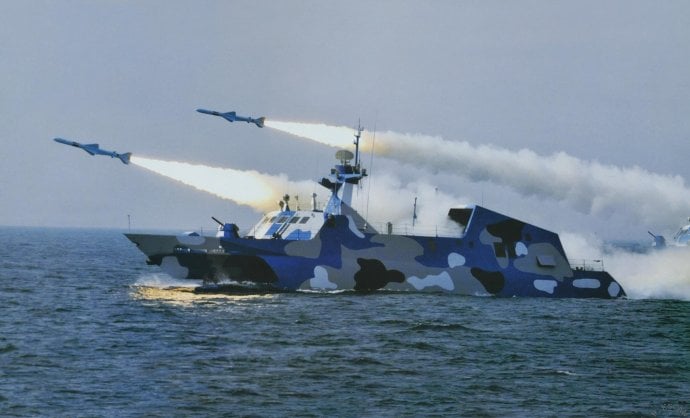
Chinese Type 022 Fast Attack Missile Craft Houbei Class firing antiship missile
I tend to understand Marines as assault capabilities to take a land based installation, but have some problem with semi-fixed Marine land-based installations (like HIMARS) that could be more easily handled by a small ship mobile weapons platform.
I'll wait to see the papers as they developed to see if this is a good meld of capabilities or just looking for a new reason to find a job to justify the USMC.
As an aside: Maybe a role for our MCDVs? ;D
:cheers:
- Reaction score
- 213
- Points
- 880
Definitely. Perhaps something they are (or should be) looking at for the NECC. Or have the NECC role absorbed by the USMC.
Colin Parkinson
Army.ca Myth
- Reaction score
- 11,939
- Points
- 1,160
While the US does Damage Control well already, I suspect there will be new lessons learned from this as well. I bet that duty watches in these refits will be beefed up in the future, to allow for a more aggressive early response and more fire patrols.
- Reaction score
- 17,116
- Points
- 1,010
tomahawk6 said:The fire is out according to the USN.
https://www.msn.com/en-us/news/us/navy-says-fire-has-been-put-out-aboard-uss-bonhomme-richard-in-san-diego/ar-BB16PA46?ocid=msedgntp
There will be reflashes for days. Trust me.
Colin Parkinson
Army.ca Myth
- Reaction score
- 11,939
- Points
- 1,160
Notice though the cable runs held, which makes moving around the ship easier.
- Reaction score
- 5,982
- Points
- 1,090
CBH99 said:I don't know anything about ships, but I'd say she's done for... in one of these photos, even the walls are warped
When you have all that pressure from hot air and combustion gases I would have been surprised if the walls were not warped. I've seen photos of the flight deck wherehuge holes appeared from collapsed structure. So much damage...
Similar threads
- Replies
- 0
- Views
- 3K
- Replies
- 0
- Views
- 9K
- Replies
- 2
- Views
- 8K



